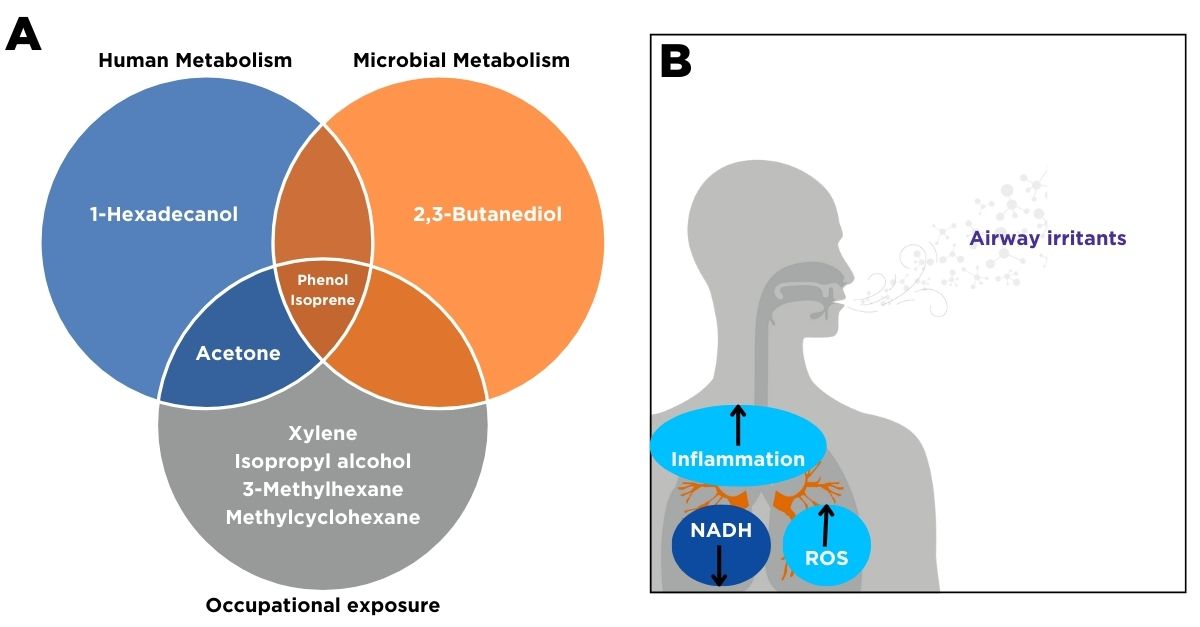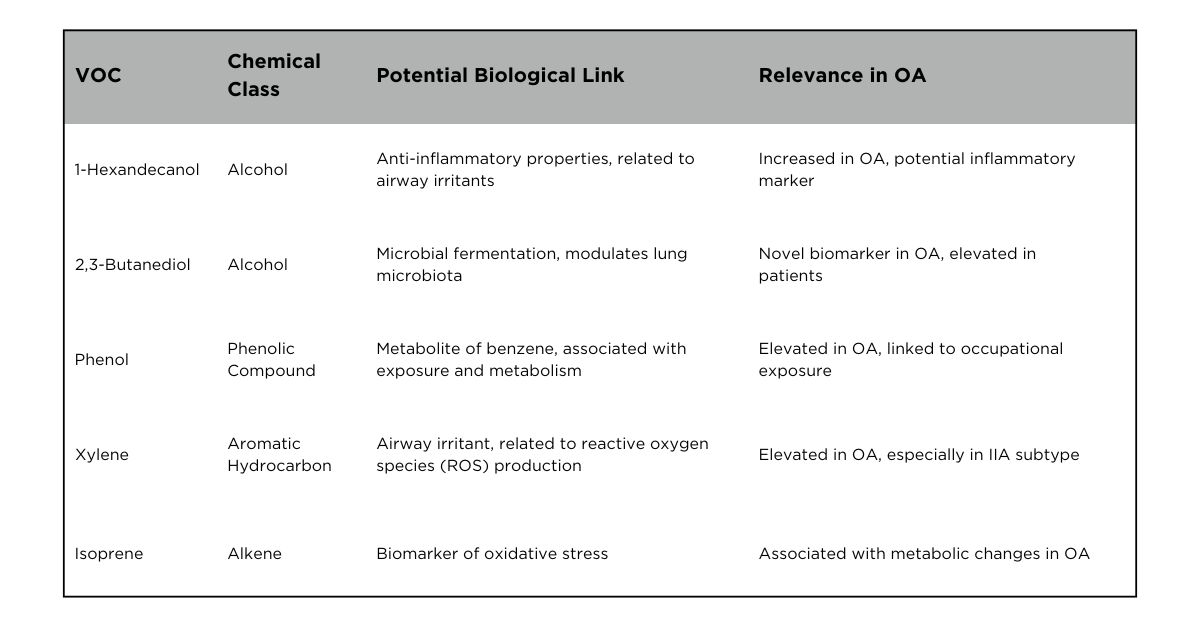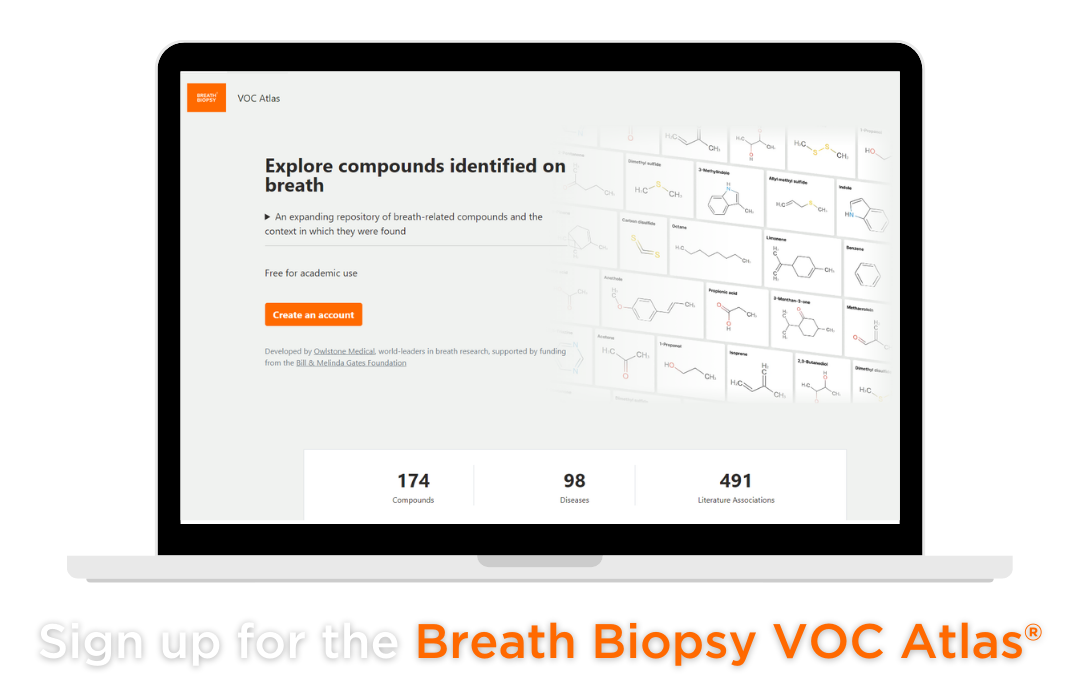Selecting Potential Breath Biomarkers for Development in Occupational Asthma Through the Breath Biopsy VOC Atlas®
In collaboration with Oslo University Hospital, Owlstone Medical has explored exhaled breath VOCs to distinguish healthy individuals from those with Occupational Asthma (OA), as well as different subtypes of OA.
| Publication information: Hilde Heiro, Tonje Trulssen Hildre, Amy Craster, Liam Grimmett, Matteo Tardelli, Bato Hammarström. Exploring exhaled breath volatile organic compounds in occupational asthma: A pilot cross-sectional study.
Disease Area: Occupational Asthma (OA) Application: Biomarker Development Sample Medium: Exhaled Breath Analysis Approach: TD-GC-MS (Thermal Desorption-Gas Chromatography-Mass Spectrometry) Summary:
|
The Need for Improved Diagnostics for Occupational Asthma
Occupational Asthma (OA) is caused by workplace exposures to respiratory irritants or allergens, leading to symptoms such as shortness of breath, wheezing, and coughing. The diagnosis of OA remains challenging, especially in distinguishing different subtypes such as allergic asthma (AA) and irritant-induced asthma (IIA). While symptom monitoring and exposure history are important for diagnosis, the ability to detect biomarkers through non-invasive methods like breath analysis could significantly improve the accuracy and speed of diagnosis.
Exhaled breath contains VOCs that reflect metabolic processes, and certain VOCs may signal specific respiratory conditions. For instance, in OA, specific breath VOCs can indicate oxidative stress, inflammation, and airway remodeling. The potential to differentiate VOC profiles across asthma subtypes and severity stages could provide clinicians with additional diagnostic tools.
Study Design and Methods:
The pilot study aimed to identify exhaled VOCs that could serve as potential biomarkers for occupational asthma, distinguishing between different subtypes of the disease as well as between OA and healthy controls. We recruited 40 patients with OA and 45 respiratory-healthy healthcare workers to serve as the control group (1).
- Sampling: Breath samples were collected using the ReCIVA® Breath Sampler, a non-invasive device designed to collect exhaled breath for VOC analysis. The participants’ breath was sampled under controlled conditions to minimize contamination and variability.
- Analytical Approach: We applied an untargeted approach using thermal desorption-gas chromatography-mass spectrometry (TD-GC-MS) to profile the VOCs in the breath samples. This allowed for the comprehensive identification of VOCs across a wide chemical spectrum, enabling the discovery of novel compounds associated with OA.
- VOCs Identification Workflow: The VOCs were chemically identified and classified into different tiers based on the confidence level of identification. In detail, Tier 1 (validated IDs) represents the highest confidence, Tier 2 (putative IDs) were matched to Owlstone Medical’s HRAM library, and Tier 3 (tentative IDs) were based on comparisons with either Owlstone’s HRAM library or the NIST library. This tiered approach, integrated within the Breath Biopsy VOC Atlas®, ensures that VOCs with higher levels of confidence can be prioritized for further investigation and development as potential biomarkers.
Results

Figure 1: Exhaled Breath VOCs Linked to Occupational Asthma. (A) Classification of volatile organic compounds (VOCs) in exhaled breath. VOCs highlighted in red—1-hexadecanol, 2,3-butanediol, phenol, and xylene—are elevated in occupational asthma and associated with nicotinamide adenine dinucleotide (NADH). (B) Proposed biological mechanism of airway inflammation: airway irritants induce quinone metabolism, generating reactive oxygen species (ROS) and leading to NADH reduction. Adapted from (1).
VOC Identification: The study identified 536 unique VOCs in the breath samples. Of these, several VOCs demonstrated significant differences in abundance between OA patients and healthy controls (p<0.05). Notably, compounds such as 1-hexadecanol, 2,3-butanediol, phenol, p-xylene, and acetone showed marked changes that were statistically significant. These compounds have either biological implications related to metabolic processes or are associated with occupational exposures, both of which may contribute to the development or exacerbation of OA.
Specific VOCs of Interest:
- 1-Hexadecanol: This compound was significantly elevated in the breath of OA patients and has been linked to airway inflammation and nuclear factor kappa B (NF-κB) activation, suggesting a role in oxidative stress and airway remodeling in response to occupational exposure (2).
- 2,3-Butanediol: This compound exhibited a 7- to 8-fold increase in OA patients compared to controls. While previously unreported in asthma, 2,3-butanediol has been associated with microbial fermentation and lung health in other studies (3-4), positioning it as a novel potential biomarker for OA.
- Phenol and Xylene (p-xylene): Both compounds were elevated in OA patients and are known to be associated with respiratory exposure to occupational irritants, potentially reflecting the metabolic processing of inhaled toxins in the body (5-7).
Pathway Analysis: Through a network of biochemical pathways, these compounds appear to share connections related to nicotinamide adenine dinucleotide (NADH) and reactive oxygen species (ROS) production. These pathways, involving oxidative stress and inflammation, are likely contributors to the development of OA. This highlights the potential of these VOCs as biomarkers, especially for distinguishing phenotypic subtypes within OA.
VOC Atlas: A Resource for Selecting Biomarkers
Owlstone Medical has developed the Breath Biopsy VOC Atlas, a centralized database that offers information on identified and quantified VOCs, as well as valuable references in multiple disease areas for researchers aiming to develop biomarkers. This publication (1) can be found in our VOC Atlas, as well as a list of potential VOC biomarkers that were detected in exhaled breath in this study.
Table 1 lists the key “on- breath” VOCs (those with signals exceeding the system background mean plus 3 standard deviations (SDs) in at least 50% of the cohort’s breath samples) found in our study, with additional information provided in our VOC Atlas, including their relevance, and their connection to the disease.

Table 1: Selected VOCs with Potential as Biomarkers in Occupational Asthma
Conclusion:
The Breath Biopsy VOC Atlas offers a robust resource for identifying and developing breath-based biomarkers for diseases like OA. By leveraging a database of confirmed on-breath VOCs, researchers can more easily select candidate biomarkers for further investigation. In the case of OA, the VOCs identified through our study—particularly those related to inflammation, microbial metabolism, and occupational exposure—hold promise for advancing the development of non-invasive diagnostic tools.
If you are interested in exploring breath-based biomarkers for OA or other respiratory conditions, access the VOC Atlas and contact us to learn more about how we can support your research.
References:
- Heiro H., Hildre T. T., Craster A., Grimmett L., Tardelli M., Hammarström B. Exploring Exhaled Breath Volatile Organic Compounds in Occupational Asthma: A Pilot Cross-Sectional Study. DOI: 10.1088/1752-7163/ad7b6a
- Attafi I M, Bakheet S A, Ahmad S F, Belali O M, Alanazi F E and Aljarboa S A 2022 Lead nitrate induces inflammation and apoptosis in rat lungs through the activation of NF-kappaB and AhR signaling pathways Environ. Sci. Pollut. Res. Int. 29 64959–70. DOI: 10.1007/s11356-022-19980-8
- Whiteson K L, Meinardi S, Lim Y W, Schmieder R, Maughan H and Quinn R 2014 Breath gas metabolites and bacterial metagenomes from cystic fibrosis airways indicate active pH neutral 2,3-butanedione fermentation ISME J. 8 1247–58 [32]. DOI: 10.1038/ismej.2013.229
- Nguyen M, Sharma A, Wu W, Gomi R, Sung B, Hospodsky D, Angenent LT, Worgall S. The fermentation product 2,3-butanediol alters P. aeruginosa clearance, cytokine response and the lung microbiome. ISME J. 2016 Dec;10(12):2978-2983. doi: 10.1038/ismej.2016.76. Epub 2016 May 14. DOI: 10.1038/ismej.2016.76
- Meyer N, Dallinga J W, Nuss S J, Moonen E J, van Berkel J J and Akdis C 2014 Defining adult asthma endotypes by clinical features and patterns of volatile organic compounds in exhaled air Respir. Res. 15 136 [23]. DOI: 10.1186/s12931-014-0136-8
- Wang Y, Han X, Li J, Zhang L, Liu Y and Jin R 2023 Associations between the compositional patterns of blood volatile organic compounds and chronic respiratory diseases and ages at onset in NHANES 2003–2012 Chemosphere 327 138425. DOI: 10.1016/j.chemosphere.2023.138425
- Hong S G, Hwang Y H, Mun S K, Kim S J, Jang H Y and Kim H 2019 Role of Th2 cytokines on the onset of asthma induced by meta-xylene in mice Environ. Toxicol. 34 1121–8. DOI: 10.1002/tox.22814
